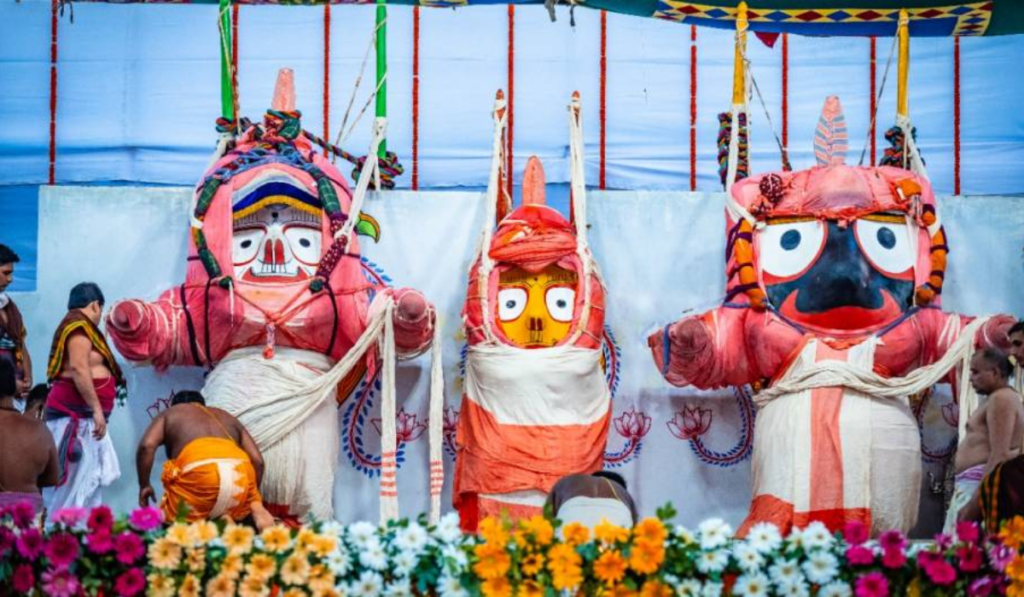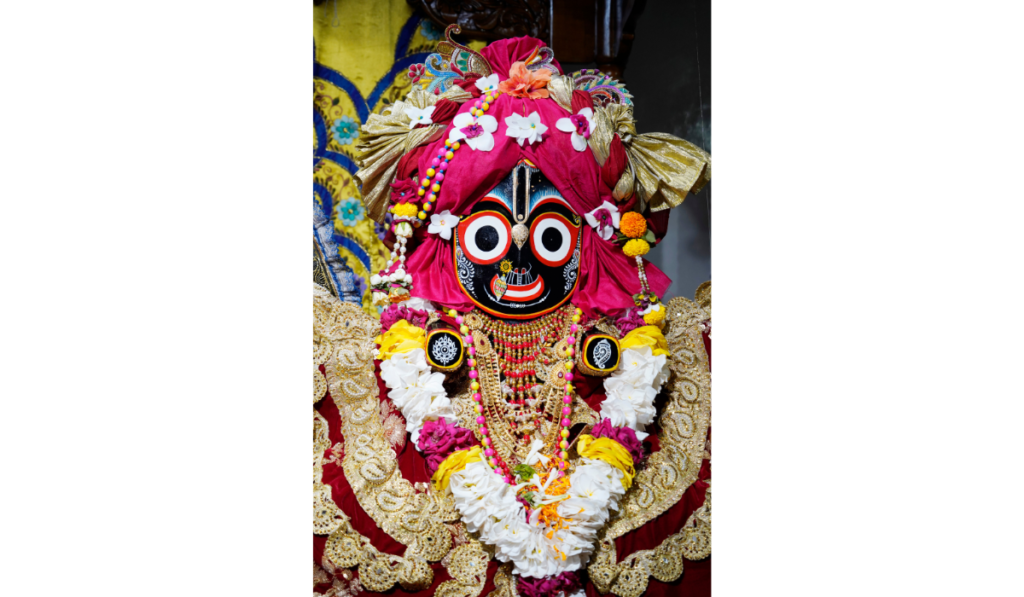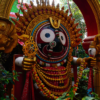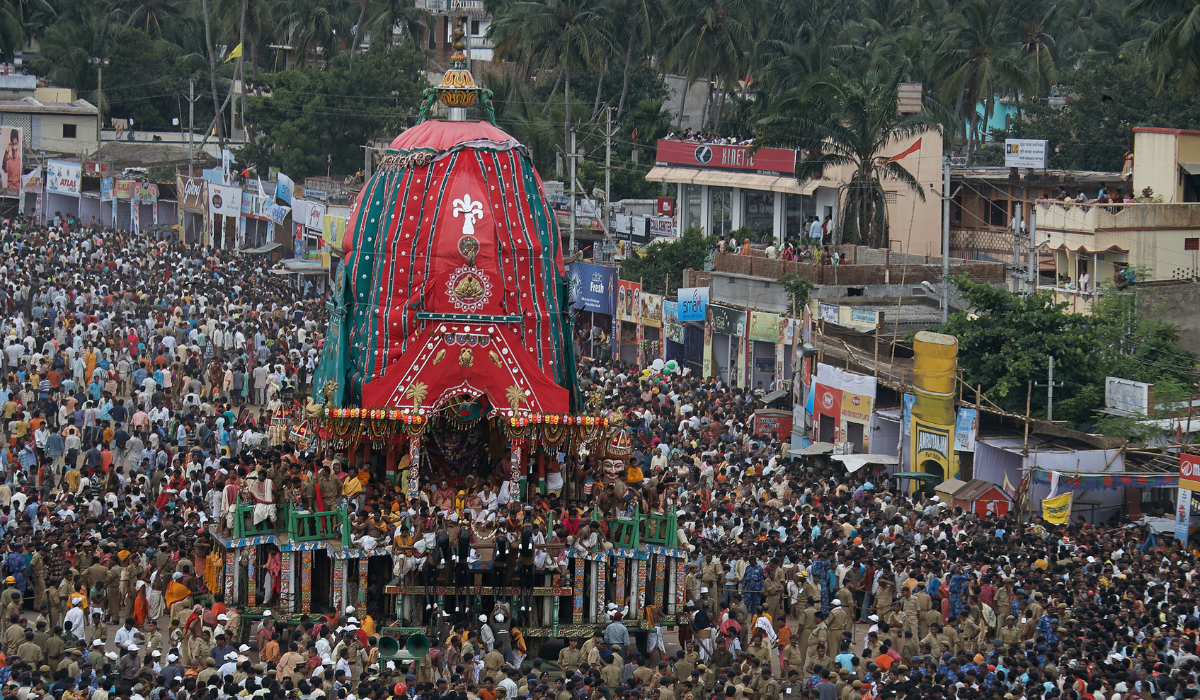This is another traditional event that commenced before starting the Rath Yatra. It is a holy bathing ceremony of Lord Jagannath, an incarnation of Lord Vishnu, along with his siblings, Lord Balabhadra and Goddess Subhadra.
This is a full moon day, 16 days before Jagannath Rath Yatra, one of the most well-known and spectacular celebrations in India, the yearly Rath Yatra chariot festival. The rite draws thousands of devotees from around the globe and has profound spiritual importance.
The Snana Purnima rituals begin with the idols of Lord Jagannath, Lord Balabhadra, and Goddess Subhadra being carried out in a magnificent procession from the temple’s garbha griha (sanctum sanctorum). The gods are then positioned in the temple’s exterior courtyard on a unique platform called “Snana Bedi.”
After that, the gods are bathed in 108 pitchers of fragrant, holy water, which is said to heal all illnesses and cleanse the body, mind, and spirit. Sandalwood paste, camphor, and a variety of herbs and flowers are combined to create this water. On Snana Purnima, followers think that dipping in this sacred water will erase all of their sins and deepen their relationship with God.
This ritual is performed by a group of priests called ‘Pandas’, who are the descendants of the original sculptors of the idols. During the bathing ceremony, the priests chant sacred mantras and offer various items, like flowers, fruits, and sweets, to the deities.
When the first round of bathing is finished, the deities are taken inside the temple for a specific ritual known as ‘Hathi Besha’. Lord Jagannath and Lord Balabhadra were dressed in elephant-like attire, which symbolizes the ten avatars of Lord Vishnu. Though this attire has its own story, we will share this story in a while.

image courtesy: OdhishaTV
Now, a second round of bathing is known as ‘Gaja Vesha’. The deities are adorned with gold ornaments and dressed in lion-like attire, representing Lord Jagannath’s lion incarnation as Narasimha. The idols are taken back to their respective chambers for a period of fifteen days following the second round of bathing. This is called ‘Anavasara‘, the time when it is thought that the gods become ill after taking a cold bath. During this period, the deities receive special herbal therapies to aid in their recovery. So, when deities are in their recovery period, Patti Dian is worshiped. Chitrakars paint the deities, and the same Pattachitra is worshiped for a fortnight during the time the deities are recuperating.
Before the commencement of Jagannath Rath Yatra, we all know that all three deities have to perform the ritual of Snan Yatra. So, after Snan Yatra it is said that all the deities got fever, however, here is a legend connected to it.
According to mythological legend, there was a devotee of Lord Jagannath named as ‘Madhavadas’. Once he fell sick with diarrhea and could not digest any food at all. This continued for many days and he finally felt that his sickness is causing distress to everyone, so he should not eat and do fasting till he is alive.
He became so weak that he could not even get up. He used to drift in and out of consciousness. This did not sit well with Lord Jagannath, who came and assisted his devotee. Lord Jagannath appeared as a young boy and started serving him by washing his solid clothes and cleaning his body smeared with stool.
When Madhavadas regained consciousness, he immediately recognized that his beloved lord was serving him. He quickly grasped his feet, and said ‘’ Lord! Why did you take so much trouble for a low wretch like me? You are omnipresent, You could have healed me easily if you merely willed it.
Lord replied “I cannot break my own rule and I cannot bear to see my devotees suffer; that’s why I served you myself. Whatever you are facing now is prarabdha karma and you have to go through it.
Then, the Lord looked at him lovingly and said you still have 15 days of this illness and you have to serve it to get liberated from this human life. That is what I serve my destitute devotees so they may expiate their karma and show the truth of this to the world.
Madhavadas still was not convinced that his Lord should serve him. After that, the Lord disappeared from view.

Seeing the distress of Madhavadas, the Lord finally said that the only way I can cure you without you having to take birth, is that I take on the illness for the next 15 days. And the Lord did the same. He told the King, and his servants, that ‘I am sick’. So, the darshan for 15 days is closed and medicine was given to the Lord.
This Parampara never stopped, and even today, the Lord falls sick every year for 15 days and He is treated for this.
Once all siblings have totally recovered from the illness, they set out for their annual journey, the Rath Yatra. This yatra takes them from the main temple to the Gundicha Temple, considered the siblings’ birthplace.
This Yatra happens because the deities want to meet their devotees as from the last 15 days none of them enjoyed the bhakti of their devotees.
Conclusion
The legends surrounding the Jagannath Rath Yatra and Snana Purnima intricately weave together the divine narratives, cultural richness, and deep-rooted traditions of Lord Jagannath’s worship. Snana Purnima, with its grand bathing ritual, marks the beginning of a unique phase where the deities fall ill and undergo a period of recovery, reflecting their human-like qualities and relatability.
This period culminates in the grand Rath Yatra, where the rejuvenated deities embark on a majestic chariot procession, symbolizing various historical and mythical events, from Lord Krishn’s departure to Mathura, his victory over Kansa, to the touching tale of the siblings’ eternal togetherness.
These celebrations are not just religious rituals but vibrant expressions of devotion, illustrating the profound bond between the divine and the devotees.
They capture the essence of community, faith, and the continuity of tradition, making the Jagannath Rath Yatra and Snana Purnima deeply mesmerizing and spiritually significant events in the cultural tapestry of India. These unfinished statues show the eternal bond between Lord Krishan, Lord Balram, and Devi Subhadra. Thus, it is time for devotees to immerse themselves in reverence and participation to seek blessings from the divine Lord Jagannath.
Let’s stay connected! Come say hi on Instagram or follow us on Facebook for daily inspo.
CATEGORIES

DIY
10 Post(s)

Fashion
3 Post(s)

Food
2 Post(s)

Health
4 Post(s)

Home Sweet Home
4 Post(s)
Spritual Pathways
3 Post(s)








